Mettlach Decorations that Vary by Size*
by Steven A. Steigerwald
Generally, the only difference between the ½-liter and 1-liter sizes of the same Mettlach stein form number is that the 1-liter stein has an enlarged view of the scene depicted on the ½-liter. However, there are a few form numbers where this generalization does not hold. On some form numbers, a black scrolling pattern has been incised into the upper and lower bands, and the scene has been enlarged. This occurs on form numbers 2585 and 2767, the two Munich Child steins, as well as
form number 2780. All three carry the same scrolling pattern in the 1-liter size.
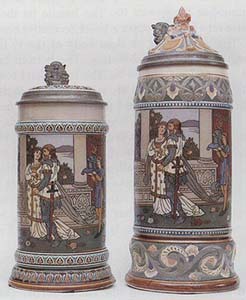 |
| Mettlach ½L 2391 and 1L 2391. Notice the bands and lids. |
One stein renowned for major differences between the ½-liter and 1-liter sizes is form number 2391, the Wedding March of the Swan Knight or Lohengrin stein. The center scene panels depicted on the two stein sizes are the same height. The circumference of the 1-liter size is approximately 1¼" greater than the ½-liter size. This permits slightly more scene to be viewed on either side of the seam on the 1-liter size. To the right of the handle, you can see another flower on the floor, the end of the second horn, as well as more bush and decorative wall. To the left of the handle, the entire sword of the knight and more wall can be seen. There is a slight variation in the scenes between the two sizes. This variation occurs in the location of the brown stripe on the floor at the bottom to the right of the center of the scene as you look at the stein from the front. On the ½-liter size this stripe starts under the back of the bride’s gown. On the 1-liter size, it starts under the feet of the bearer of Lohengrin’s swan helmet.
The decorative bands on the top and bottom of the center panel on the ½-liter size of form number 2391 are raised and bear a repeating pattern. They are glazed blue and red. The top band on the ½-liter size is plain gray and the base band has an incised repeating pattern which has three glaze colors. The base is raised and the handle is squared. The inlay is incised and depicts a shield of a swimming swan surrounded by a red border. The incised shield is enclosed in a circular raised band in the same decorative and glaze pattern as the bands on the top and bottom of the scene.
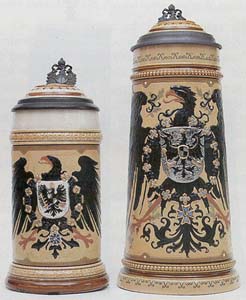 |
| Mettlach ½L 2204 and 1L 2204. Notice the bases and upper decorative bands. |
On either side of the center panel on the 1-liter size of form number 2391 are blue bands with raised beads which have been gilded. Fancy multicolored bands are on either side of the beaded bands. The lower band forms the base band. The base is flat, which diminishes the height difference in the bodies of the two sizes. The inlay on the 1-liter size is a castle finial surrounded by a wall with fancy relief panels leading from the castle wall to the pewter rim. The handle on this size has a relief winged gargoyle at the base and a relief house at the top. The house may have been designed as a guardhouse for the castle finial located on the inlay. A fancy decorative multicolored bar connects the gargoyle to the house. The thumblifts on both sides depict a winged cherub holding a goblet in its right hand with a banner over its head. The cherub sits atop a helmet which sits atop a shield. The thumblift on the 1 liter size is an enlarged view of the thumblift on the ½ liter size and is approximately ¾" longer.
Another stein renowned for differences between the ½-liter and 1-liter sizes is form number 2204, sometimes incorrectly called the Blue Max stein. Other than the thumblift and the design of the inlay, there is nothing identical about these two sizes of the same form number. The inlays depict a crown on a banner in the center. The crown and banner are surrounded by a relief band and then a fancy decorated band. There are three additional concentric bands completing the inlay. The outermost band that sits in the pewter and the inner band which surrounds the fancy decorated band are white on the ½-liter size and tan on the 1-liter size. The white on the ½-liter size is consistent with the white stoneware from which its inlay and stein body are made. The tan color on the 1-liter size is consistent with the tan color of the stoneware from which its inlay and body are made.
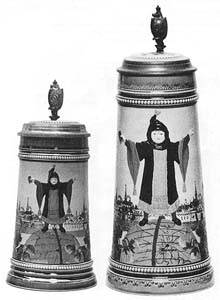 |
| Mettlach ½L 2585 and 1L 2585. Notice the scrolling on the bands of the 1L stein. |
The pewter tongue on the handles of the ½-liter and 1-liter sizes of number 2204 is different. The tongue on the 1-liter is triangular and runs approximately 1 inch down the handle, while the tongue on the ½-liter size is only ½-inch long and is rounded off. This is due to the difference between the handles on the two sizes. The handle on the 1-liter size is formed to look like a tooled leather handle, with studs running down the center of the outer surface. It runs from the decorative band at the top of the scene to approximately 1 inch above the lower decorative band. The handle on the ½-liter size is a typical Mettlach stein handle shape with a raised area to accommodate the pewter tongue. The handle on the ½-liter size runs from the upper to the lower decorative bands.
The upper band on the stein body of the ½-liter size of form number 2204 is white. The bottom base band is raised and glazed brown. The upper and lower bands on the 1-liter size are tan with the same incised scrolling pattern found on the 1-liter size of form numbers 2585, 2767 and 2780. The decorative bands on either side of the scene on the ½-liter size are raised relief bearing a repeating pattern, which looks like leaves on a vine, surrounded by a smaller raised band on either side. These bands are glazed tan. The decorative band at the top of the scene on the 1-liter size has one raised band, an indented band, and a band of raised beads. The bottom band is reversed. The bands are glazed brown and the beads are gilded.
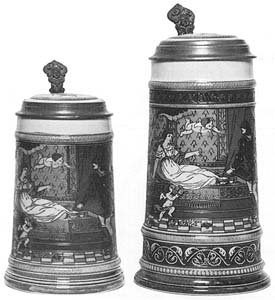 |
| Mettlach ½L 2401 and 1L 2401. Notice the bases. |
The frame around the center scenes in both sizes of the 2204 stein is a dark tan border with intermittent half-moon shapes descending into the center scene. The 1-liter size has white beads in these half-moon shapes, whereas the ½-liter size does not. At the back of the stein on either side of the seam, there is a scrolling pattern. The pattern runs the length of the seam on the ½-liter size. The scrolling pattern is similar but not identical on the 1-liter size and runs only the distance of the open underside of the handle. The center scene in both sizes is a raised full-color relief imperial eagle. However, the eagle on the 1-liter size is much larger and more ornate. The wings bear the same number of feathers but there is much more detail work on the 1-liter size. There are also additional feather tufts at the tip of each wing on the 1-liter size which frame the eagle’s head. The head and tail of the eagle on the 1-liter size are also more ornate and have additional tufts of feathers.
The small eagle in the central shield on form number 2204 is also much more detailed and ornate on the 1-liter size. The eagle in this center shield on the ½-liter size has a reddish brown beak and talons, while the beak and talons on the eagle on the center shield of the 1-liter size have been gilded. The small shield on the chest of the eagle on the center shield is also different. This shield is divided into four quadrants. Two of the quadrants are black and two are silver. On the ½-liter size, the black quadrants are the upper right and lower left, whereas the black quadrants on the 1-liter size are the upper left and lower right.
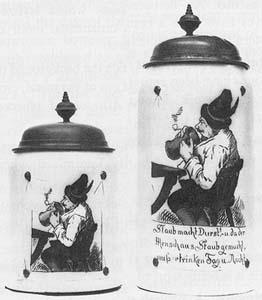 |
| Mettlach ½L 1646 and 1L 1646. Notice the verse on the 1L stein. |
The decorative touches added on either side of the eagle on the ½-liter size of form number 2204 consist of two vertical rows of three clusters of oak leaves with acorns. The clusters on the 1-liter size are slightly more ornate and run in four vertical rows of three at either side of the head of the eagle. These rows continue to run under the eagle so that not all 24 clusters are visible. The rows are staggered so that the first row to either side of the handle starts in a certain location and the next row is slightly higher. The third row starts at the same location as the first and the fourth starts at the same height as the second.
There is a further variation of the 1-liter size of the 2204 which bears form number 1956. On that stein, the jeweled necklace with the iron cross which hangs from the eagle’s neck is deleted and the eagle shield on the chest of the eagle is replaced by a cameo shield depicting a side view of the bust of Wilhelm I.
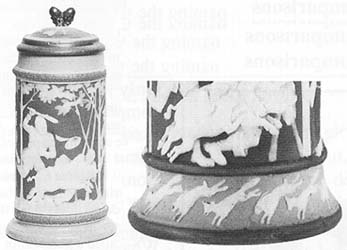 |
| Mettlach ½L 2350 with plain base, and close-up of base area of 1L 2350, showing running rabbits and foxes. |
On the 1-liter size of form number 2401, Tannheuser in the Venusberg, fancy decorated bands have been added above and below the etched scene. The height of these bands equals the difference in height between the ½-liter and 1-liter sizes. The height of the etched scene on this form number is approximately the same on both sizes. A color variation also exists in both sizes. The feather fan at the top of the etched scene above the reclining maiden comes in either a dark forest green or a light pastel green.
There are also variations as to what is depicted on the front of certain ½-liter and 1-liter tapestry steins of the same form number. These variations occur when the verse and banner located on the back of the ½-liter size, under the handle, are deleted and a new verse is added to the bottom of the tapestry on the front of the 1-liter size stein. This occurs on form numbers 1533, 1646 and 1647.
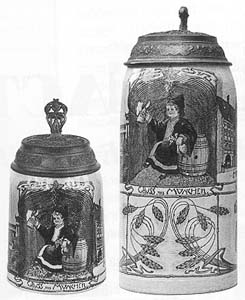 |
| Mettlach ½L 1141(1526) an 1L 1141(1526). Note the bottom half of the 1L stein. |
Still another variation exists as to what is depicted on the ½-liter and 1-liter sizes of one of the cameo Coat of Arms steins (form number 2950) and the cameo Boar Hunt stein (form number 2530). On the Bavarian Coat of Arms stein (form number 2950), tiered strings of cameo jewels have been added on the 1-liter size. These jewels have been added to the bottom of the Bavarian coat of arms, which depicts two crowned lions on either side of the crowned Bavarian shield. On the cameo Boar Hunt stein (form number 2530), a band of relief rabbits and foxes, depicted landing on their front paws after jumping, has been added to the base, under (and separate from) the cameo scene.
One liter and ½-liter form 1526 PUGs frequently contain significant differences for a given decoration. This is due to a large height difference and essentially equal diameters for the two sizes. The most striking example is decoration 1114 where the bottom half of the 1-liter decoration is eliminated on the ½-liter. Another interesting example is decoration 1108 which, when expanded from ½-liter to 1-liter, had several people eliminated, as well as Heinrich Schlitt’s signature.
__________
*Reprinted from The Beer Stein Journal, February 1995, by permission from Gary Kirsner Auctions.








